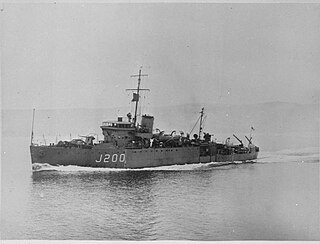
HMS Peterhead was a Bangor-class minesweepers built for the Royal Navy during the Second World War.
HMS Rye (J76) was a Bangor-class minesweeper built for the Royal Navy during the Second World War.

HMS Speedy was one of 21 Halcyon-class minesweepers built for the Royal Navy in the 1930s.

HMS Hebe was one of 21 Halcyon-class minesweepers built for the Royal Navy in the 1930s. Commissioned in 1936, Hebe served during World War II, notably taking part in the Dunkirk evacuation in 1940 and then serving in the Mediterranean, carrying out minesweeping operations from Malta. After taking part in several operations, including Operations Harpoon and Torch, and the invasion of Pantelleria, Hebe was sunk by a mine off Bari in November 1943, with the loss of 37 of the vessel's crew.

HMS Hydra was a reciprocating engine-powered Algerine-class minesweeper built for the Royal Navy during the Second World War. She was badly damaged during the war and was scrapped in 1947.

HMS Providence was a reciprocating engine-powered Algerine-class minesweeper during the Second World War. Laid down as HMCS Forrest Hill for the Royal Canadian Navy she was transferred on completion to the Royal Navy as HMS Providence. She survived the war and was scrapped in 1958.
HMIS Kathiawar (J155) was a Bangor-class minesweeper built for the Royal Navy, but transferred to the Royal Indian Navy (RIN) during the Second World War.
HMIS Baluchistan (J182) was a Bangor-class minesweeper built for the Royal Navy, but transferred to the Royal Indian Navy (RIN) during the Second World War.
HMIS Khyber (J190) was a Bangor-class minesweeper built for the Royal Navy, but transferred to the Royal Indian Navy (RIN) during the Second World War.
HMIS Rohilkhand (J180) was a Bangor-class minesweeper built for the Royal Navy, but transferred to the Royal Indian Navy (RIN) during the Second World War.
HMIS Kumaon (J182) was a Bangor-class minesweeper built for the Royal Navy, but transferred to the Royal Indian Navy (RIN) during the Second World War.
HMIS Carnatic (J182) was a Bangor-class minesweeper built for the Royal Navy, but transferred to the Royal Indian Navy (RIN) during the Second World War.
HMIS Rajputana (J197) was a Bangor-class minesweepers built for the Royal Navy, but transferred to the Royal Indian Navy (RIN) during the Second World War.

HMIS Orissa (J200) was a Bangor-class minesweepers built for the Royal Navy, but transferred to the Royal Indian Navy (RIN) during the Second World War.
HMIS Bihar (J247) was a Bangor-class minesweeper built for the Royal Navy. It transferred to the Royal Indian Navy (RIN) during the Second World War.
HMIS Konkan (J228) was a Bangor-class minesweepers built for the Royal Navy, but transferred to the Royal Indian Navy (RIN) during the Second World War.
HMIS Deccan (J129) was a Bangor-class minesweepers built for the Royal Navy, but transferred to the Royal Indian Navy (RIN) during the Second World War.
HMS Lyme Regis was a Bangor-class minesweeper built for the Royal Navy during the Second World War.

HMS Gleaner was one of 21 Halcyon-class minesweepers built for the Royal Navy in the 1930s.

HMS Lennox (J276) was a reciprocating engine-powered Algerine-class minesweeper during the Second World War.








